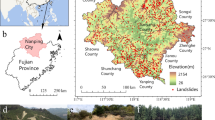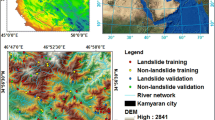Abstract
Recent advancements have seen a pervasive application of machine learning methodologies in assessing the susceptibility of geological hazards. A pivotal element influencing the accuracy of model predictions resides in the prudent selection of model parameters within machine learning frameworks. The objective of this study is to develop a robust landslide susceptibility assessment model by refining the support vector machine (SVM) model through the employment of the Bayesian algorithm for hyperparameter optimization. The southern part of the Qinghai-Tibet Plateau, focusing on major highways, is selected as the study area. Nine influencing factors, namely the elevation, slope, aspect, profile curvature, lithology, topographic wetness index, normalized difference vegetation index, distance to faults, and distance to rivers, are selected as the conditioning variables instrumental in evaluating the likelihood of collapse occurrences. Secondly, data from field surveys involving 351 landslides and randomly generated non-landslide data are utilized in a balanced 1:1 ratio to construct the training and testing datasets. Next, the cross-validation loss rate of the SVM model is selected as the objective function, and the Bayesian algorithm is used to optimize the BoxConstraint and KernelScale parameters of the SVM model, resulting in a Bayesian optimization-based SVM model. The results show that, within a five-fold cross-validation framework, the model yields 99.15% and 96.32% accuracy for the training and testing datasets, respectively. Concurrently, the area under the receiver operating characteristic curve values are recorded at 99.76% and 98.67% for the respective datasets, highlighting a notable level of predictive proficiency. Furthermore, factor importance ranking reveals lithology and elevation as the most influential, with partial dependence plots identifying high susceptibility areas between elevations of 2916 and 3954 m under soft lithology conditions. A collapse susceptibility map encompassing the entire study area is encompassing, categorizing the study area into extremely high (7.79%), high (13.38%), moderate (29.99%), and low (48.84%) susceptibility zones.












Similar content being viewed by others
Data availability
Data will be made available on request.
References
Agboola G, Beni LH, Elbayoumi T, Thompson G (2024) Optimizing landslide susceptibility mapping using machine learning and geospatial techniques. Ecol Inf 81:102583. https://doi.org/10.1016/j.ecoinf.2024.102583
Bennett ND, Croke BFW, Guariso G, Guillaume JHA, Hamilton SH, Jakeman AJ, Marsili-Libelli S, Newham LTH, Norton JP, Perrin C, Pierce SA, Robson B, Seppelt R, Voinov AA, Fath BD, Andreassian V (2013) Characterising performance of environmental models. Environ Modell Softw 40:1–20. https://doi.org/10.1016/j.envsoft.2012.09.011
Brenning A (2005) Spatial prediction models for landslide hazards: review, comparison and evaluation. Nat Hazards Earth Syst Sci 5:853–862. https://doi.org/10.5194/nhess-5-853-2005
Brenning A, Long S, Fieguth P (2012) Detecting rock glacier flow structures using gabor filters and ikonos imagery. Remote Sens Environ 125:227–237. https://doi.org/10.1016/j.rse.2012.07.005
Chang Z, Huang J, Huang F, Bhuyan K, Meena SR, Catani F (2023) Uncertainty analysis of non-landslide sample selection in landslide susceptibility prediction using slope unit-based machine learning models. Gondwana Res 117:307–320. https://doi.org/10.1016/j.gr.2023.02.007
Chung C-JF, Fabbri AG (2003) Validation of spatial prediction models for landslide hazard mapping. Nat Hazard 30:451–472. https://doi.org/10.1023/B:NHAZ.0000007172.62651.2b
Cui P, Jia Y, Su F, Ge Y, Chen X, Zou Q (2017) Natural hazards in tibetan plateau and key issue for feature research. Bull Chin Acad Sci 32:985–992
Daviran M, Shamekhi M, Ghezelbash R, Maghsoudi A (2023) Landslide susceptibility prediction using artificial neural networks, svms and random forest: hyperparameters tuning by genetic optimization algorithm. Int J Environ Sci Technol 20:259–276. https://doi.org/10.1007/s13762-022-04491-3
Dormann CF, Elith J, Bacher S, Buchmann C, Carl G, Carré G, Marquéz JRG, Gruber B, Lafourcade B, Leitão PJ, Münkemüller T, McClean C, Osborne PE, Reineking B, Schröder B, Skidmore AK, Zurell D, Lautenbach S (2013) Collinearity: a review of methods to deal with it and a simulation study evaluating their performance. Ecography 36:27–46. https://doi.org/10.1111/j.1600-0587.2012.07348.x
Du Y,Yi J (2020) Vegetation index data of qinghai tibet plateau (2000–2018). In: National Tibetan Plateau Data C (ed), National Tibetan Plateau Data Center
Feizizadeh B, Shadman Roodposhti M, Jankowski P, Blaschke T (2014) A gis-based extended fuzzy multi-criteria evaluation for landslide susceptibility mapping. Comput Geosci 73:208–221. https://doi.org/10.1016/j.cageo.2014.08.001
Ferlisi S, Marchese A, Peduto D (2021) Quantitative analysis of the risk to road networks exposed to slow-moving landslides: a case study in the campania region (southern italy). Landslides 18:303–319. https://doi.org/10.1007/s10346-020-01482-8
Friedman JH (2001) Greedy function approximation: a gradient boosting machine. Ann Stat 29:1189–1232
Goetz JN, Brenning A, Petschko H, Leopold P (2015) Evaluating machine learning and statistical prediction techniques for landslide susceptibility modeling. Comput Geosci 81:1–11. https://doi.org/10.1016/j.cageo.2015.04.007
Gupta SK, Shukla DP (2023) Handling data imbalance in machine learning based landslide susceptibility mapping: a case study of mandakini river basin, north-western himalayas. Landslides 20:933–949. https://doi.org/10.1007/s10346-022-01998-1
Guzzetti F, Reichenbach P, Ardizzone F, Cardinali M, Galli M (2006) Estimating the quality of landslide susceptibility models. Geomorphology 81:166–184. https://doi.org/10.1016/j.geomorph.2006.04.007
He Q, Wang M, Liu K (2021) Rapidly assessing earthquake-induced landslide susceptibility on a global scale using random forest. Geomorphology 391:107889. https://doi.org/10.1016/j.geomorph.2021.107889
Hong H (2023) Assessing landslide susceptibility based on hybrid best-first decision tree with ensemble learning model. Ecol Indic 147:109968. https://doi.org/10.1016/j.ecolind.2023.109968
Hong H, Pourghasemi HR, Pourtaghi ZS (2016) Landslide susceptibility assessment in lianhua county (china): a comparison between a random forest data mining technique and bivariate and multivariate statistical models. Geomorphology 259:105–118. https://doi.org/10.1016/j.geomorph.2016.02.012
Hong H, Panahi M, Shirzadi A, Ma T, Liu J, Zhu AX, Chen W, Kougias I, Kazakis N (2018) Flood susceptibility assessment in hengfeng area coupling adaptive neuro-fuzzy inference system with genetic algorithm and differential evolution. Remote Sens Environ 621:1124–1141. https://doi.org/10.1016/j.scitotenv.2017.10.114
Huang Y, Zhao L (2018) Review on landslide susceptibility mapping using support vector machines. CATENA 165:520–529. https://doi.org/10.1016/j.catena.2018.03.003
Jin H, Wei Z, Wang S, Yu Q, Lü L, Wu Q, Ji Y (2008) Assessment of frozen-ground conditions for engineering geology along the qinghai–tibet highway and railway, china. Eng Geol 101:96–109. https://doi.org/10.1016/j.enggeo.2008.04.001
Kang L, Chen RS, Xiong N, Chen YC, Hu YX, Chen CM (2019) Selecting hyper-parameters of gaussian process regression based on non-inertial particle swarm optimization in internet of things. IEEE Access 7:59504–59513. https://doi.org/10.1109/ACCESS.2019.2913757
Lee J-H, Sameen MI, Pradhan B, Park H-J (2018) Modeling landslide susceptibility in data-scarce environments using optimized data mining and statistical methods. Geomorphology 303:284–298. https://doi.org/10.1016/j.geomorph.2017.12.007
Li Y, Sheng Y, Chai B, Zhang W, Zhang T, Wang J (2020) Collapse susceptibility assessment using a support vector machine compared with back-propagation and radial basis function neural networks. Geomatics Nat Hazards Risk 11:510–534. https://doi.org/10.1080/19475705.2020.1734101
Moayedi H, Xu M, Naderian P, Ahmadi Dehrashid A, Thi QT (2024) Validation of four optimization evolutionary algorithms combined with artificial neural network (ann) for landslide susceptibility mapping: a case study of gilan, iran. Ecol Eng 201:107214. https://doi.org/10.1016/j.ecoleng.2024.107214
Nowicki Jessee MA, Hamburger MW, Allstadt K, Wald DJ, Robeson SM, Tanyas H, Hearne M, Thompson EM (2018) A global empirical model for near-real-time assessment of seismically induced landslides. J Geophys Res: Earth Surf 123:1835–1859. https://doi.org/10.1029/2017JF004494
Peng S (2020) 1-km monthly precipitation dataset for china (1901–2022). In: National Tibetan Plateau Data C (ed), National Tibetan Plateau Data Center
Pham BT, Pradhan B, Tien Bui D, Prakash I, Dholakia MB (2016) A comparative study of different machine learning methods for landslide susceptibility assessment: a case study of uttarakhand area (india). Environ Modell Softw 84:240–250. https://doi.org/10.1016/j.envsoft.2016.07.005
Riegel RP, Alves DD, Schmidt BC, de Oliveira GG, Haetinger C, Osório DMM, Rodrigues MAS, de Quevedo DM (2020) Assessment of susceptibility to landslides through geographic information systems and the logistic regression model. Nat Hazard 103:497–511. https://doi.org/10.1007/s11069-020-03997-8
San BT (2014) An evaluation of svm using polygon-based random sampling in landslide susceptibility mapping: the candir catchment area (Western Antalya, Turkey). Int J Appl Earth Obs Geoinf 26:399–412. https://doi.org/10.1016/j.jag.2013.09.010
Sun D, Wen H, Wang D, Xu J (2020) A random forest model of landslide susceptibility mapping based on hyperparameter optimization using bayes algorithm. Geomorphology 362:107201. https://doi.org/10.1016/j.geomorph.2020.107201
Sun D, Xu J, Wen H, Wang D (2021) Assessment of landslide susceptibility mapping based on Bayesian hyperparameter optimization: a comparison between logistic regression and random forest. Eng Geol 281:105972. https://doi.org/10.1016/j.enggeo.2020.105972
Tanyu BF, Abbaspour A, Alimohammadlou Y, Tecuci G (2021) Landslide susceptibility analyses using random forest, c4.5, and c5.0 with balanced and unbalanced datasets. CATENA 203:105355. https://doi.org/10.1016/j.catena.2021.105355
Tehrany MS, Jones S, Shabani F (2019) Identifying the essential flood conditioning factors for flood prone area mapping using machine learning techniques. CATENA 175:174–192. https://doi.org/10.1016/j.catena.2018.12.011
Tien Bui D, Pradhan B, Lofman O, Revhaug I (2012) Landslide susceptibility assessment in vietnam using support vector machines, decision tree, and naïve bayes models. Math Probl Eng 2012:974638. https://doi.org/10.1155/2012/974638
Tien Bui D, Tuan TA, Klempe H, Pradhan B, Revhaug I (2016) Spatial prediction models for shallow landslide hazards: a comparative assessment of the efficacy of support vector machines, artificial neural networks, kernel logistic regression, and logistic model tree. Landslides 13:361–378. https://doi.org/10.1007/s10346-015-0557-6
Vapnik VN (1999) An overview of statistical learning theory. IEEE Trans Neural Netw 10:988–999. https://doi.org/10.1109/72.788640
Wang Z, Fan H, Wang D, Xing T, Wang D, Guo Q, Xiu L (2021) Spatial pattern of highway transport dominance in qinghai–tibet plateau at the county scale. ISPRS Int J Geo-Inf 10:304
Wen H, Xie P, Xiao P, Hu D (2017) Rapid susceptibility mapping of earthquake-triggered slope geohazards in lushan county by combining remote sensing with the ahp model developed for the wenchuan earthquake. Bull Eng Geol Environ 76:909–921. https://doi.org/10.1007/s10064-016-0957-4
Xie W, Chen W, Shen L, Duan J, Yang M (2021) Surrogate network-based sparseness hyper-parameter optimization for deep expression recognition. Pattern Recognit 111:107701. https://doi.org/10.1016/j.patcog.2020.107701
Xu C, Dai F, Xu X, Lee YH (2012) Gis-based support vector machine modeling of earthquake-triggered landslide susceptibility in the jianjiang river watershed, china. Geomorphology 145–146:70–80. https://doi.org/10.1016/j.geomorph.2011.12.040
Yao X, Tham LG, Dai FC (2008) Landslide susceptibility mapping based on support vector machine: a case study on natural slopes of hong kong, china. Geomorphology 101:572–582. https://doi.org/10.1016/j.geomorph.2008.02.011
Youssef AM, Pourghasemi HR, Pourtaghi ZS, Al-Katheeri MM (2016) Landslide susceptibility mapping using random forest, boosted regression tree, classification and regression tree, and general linear models and comparison of their performance at wadi tayyah basin, asir region, saudi arabia. Landslides 13:839–856. https://doi.org/10.1007/s10346-015-0614-1
Yu C, Liu K, Yu B, Yin J (2023) Gis-based study on the susceptibility of shallow landslides: a case study of mass shallow landslides in sanming, fujian in 2019. Nat Hazard 115:2553–2575. https://doi.org/10.1007/s11069-022-05653-9
Zeng T, Wu L, Peduto D, Glade T, Hayakawa YS, Yin K (2023) Ensemble learning framework for landslide susceptibility mapping: different basic classifier and ensemble strategy. Geosci Front 14:101645. https://doi.org/10.1016/j.gsf.2023.101645
Zhang J, Ma X, Zhang J, Sun D, Zhou X, Mi C, Wen H (2023a) Insights into geospatial heterogeneity of landslide susceptibility based on the shap-xgboost model. J Environ Manage 332:117357. https://doi.org/10.1016/j.jenvman.2023.117357
Zhang Y, Xu P, Liu J, He J, Yang H, Zeng Y, He Y, Yang C (2023b) Comparison of lr, 5-cv svm, ga svm, and pso svm for landslide susceptibility assessment in tibetan plateau area, china. J Mountain Sci 20:979–995. https://doi.org/10.1007/s11629-022-7685-y
Acknowledgements
We extend our heartfelt gratitude to everyone who has contributed to this article for their invaluable guidance and support throughout this study.
Funding
This work was financed by the Second Tibetan Plateau Scientific Expedition and Research Program (STEP) (Grant No. 2019QZKK0904), the National Natural Science Foundation of China (Grant No. 42177146), and the Science and the Key Research and Development Plan of Yunnan Province (Grant No. 202103AA080013).
Author information
Authors and Affiliations
Corresponding author
Ethics declarations
Conflict of interest
The authors have no conflict of interest.
Additional information
Publisher's Note
Springer Nature remains neutral with regard to jurisdictional claims in published maps and institutional affiliations.
Rights and permissions
Springer Nature or its licensor (e.g. a society or other partner) holds exclusive rights to this article under a publishing agreement with the author(s) or other rightsholder(s); author self-archiving of the accepted manuscript version of this article is solely governed by the terms of such publishing agreement and applicable law.
About this article
Cite this article
Sun, K., Li, Z., Wang, S. et al. A support vector machine model of landslide susceptibility mapping based on hyperparameter optimization using the Bayesian algorithm: a case study of the highways in the southern Qinghai–Tibet Plateau. Nat Hazards (2024). https://doi.org/10.1007/s11069-024-06665-3
Received:
Accepted:
Published:
DOI: https://doi.org/10.1007/s11069-024-06665-3




